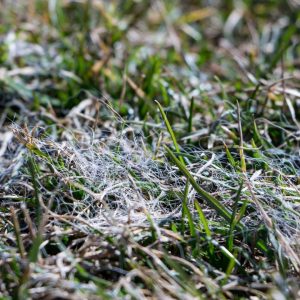Snow Mold in Ohio
December 8, 2020 | By: Scott Robinson

Microdochium Patch (aka pink snow mold) and Typhula Blight (aka gray snow mold) differ from the many other cool-season turf diseases because instead of being an issue during spring, summer, and fall during warm to hot temperatures, these fungi flourish and damage turf in temperatures of 32 to 60 degrees F.
These diseases are typically more of a problem on highly maintained and fertilized turf. Golf courses annually deal with snow mold prevention and control on their tees and greens.
Ideal Conditions
- Cold, cloudy, wet conditions with or without snow cover
- When the turf, thatch layer, and upper soil profile remains wet or saturated for extended periods
As winters have become milder with less snowfall, gray snow mold has become less of a problem. However, pink snow mold doesn’t need snow. It just needs cold and wet conditions to rapidly increase populations in turf areas and cause considerable damage. This damage becomes obvious in early spring. Pink snow mold can stay active and spread further in the turf as long as conditions remain cold and wet into mid-spring.
What to look for
Symptoms of these two diseases are similar; they both create circular patches a few inches to up to two feet in diameter of tan, straw brown, or whitish turf, which in wet conditions often has a melted look in the centers along with visible mycelium. Usually, with pink snow mold around the patches’ margins, you will see a smoke ring with pink/red cast to it caused by the red sclerotia versus a gray/black appearance from the black sclerotia on gray snow mold. While the disease is active, the patches can increase in diameter, and flowing water or traffic on turf, human or mechanical, can spread fungus and create new patches.
Cultural Practices to help reduce Snow Mold
Cultural practices that can reduce snow mold incidents include mowing turf a final time after dormancy in the fall. This will minimize excessive leaf tissue. Be sure to remove all clippings, tree leaves, and turf debris from turf before winter weather arrives as well. Core aerating or verticutting to reduce the thatch layer and compaction in the turf and improve drainage. In areas of turf where water lies for long periods, consider sub-surface drainage. Or recontouring the soil profile to improve drainage. In the spring, on damaged or dead turf areas, rake and cultivate matted spots, overseed, fertilize, and promote new turf development.
Fungicides to prevent or control Snow Mold
Most golf courses apply a couple of preventative fungicide applications to their tees and greens early, and mid-winter to prevent disease outbreaks and have their turf ready for busy spring business as soon as the weather breaks. They don’t have time for repair and recovery of damaged turf during this busy season. Most other turf managers only apply curative fungicide applications in the spring if they have a severe outbreak on turf that has high expectations of quality on it. Many will repair areas or, if less extensive damage, allow turf to recover with normal springtime growth. The best fungicides for snow mold prevention and control are combination products with both systemic and contact fungicides included. Some of our favorites are: Headway, Instrata, Concert, or Enclave.
Browse all our great fungicides here or contact us to consult with one of our turf specialists.